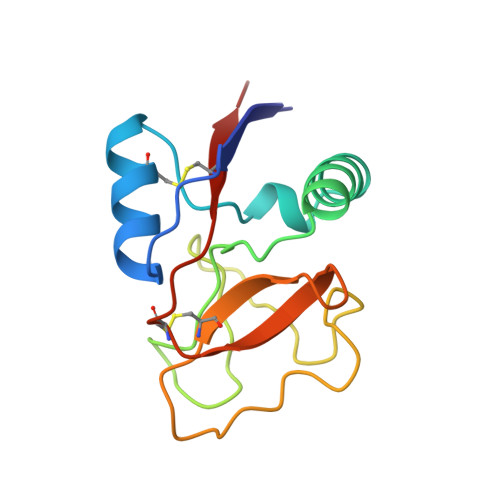The structure of a tunicate C-type lectin from Polyandrocarpa misakiensis complexed with D -galactose.
Poget, S.F., Legge, G.B., Proctor, M.R., Butler, P.J., Bycroft, M., Williams, R.L.(1999) J Mol Biology 290: 867-879
- PubMed: 10398588
- DOI: https://doi.org/10.1006/jmbi.1999.2910
- Primary Citation of Related Structures:
1BYF, 1TLG - PubMed Abstract:
C-type lectins are calcium-dependent carbohydrate-recognising proteins. Isothermal titration calorimetry of the C-type Polyandrocarpa lectin (TC14) from the tunicate Polyandrocarpa misakiensis revealed the presence of a single calcium atom per monomer with a dissociation constant of 2.6 microM, and confirmed the specificity of TC14 for D -galactose and related monosaccharides. We have determined the 2.2 A X-ray crystal structure of Polyandrocarpa lectin complexed with D -galactose. Analytical ultracentrifugation revealed that TC14 behaves as a dimer in solution. This is reflected by the presence of two molecules in the asymmetric unit with the dimeric interface formed by antiparallel pairing of the two N-terminal beta-strands and hydrophobic interactions. TC14 adopts a typical C-type lectin fold with differences in structure from other C-type lectins mainly in the diverse loop regions and in the second alpha-helix, which is involved in the formation of the dimeric interface. The D -galactose is bound through coordination of the 3 and 4-hydroxyl oxygen atoms with a bound calcium atom. Additional hydrogen bonds are formed directly between serine, aspartate and glutamate side-chains of the protein and the sugar 3 and 4-hydroxyl groups. Comparison of the galactose binding by TC14 with the mannose binding by rat mannose-binding protein reveals how monosaccharide specificity is achieved in this lectin. A tryptophan side-chain close to the binding site and the distribution of hydrogen-bond acceptors and donors around the 3 and 4-hydroxyl groups of the sugar are essential determinants of specificity. These elements are, however, arranged in a very different way than in an engineered galactose-specific mutant of MBPA. Possible biological functions can more easily be understood from the fact that TC14 is a dimer under physiological conditions.
- Cambridge Centre for Protein Engineering, Department of Chemistry, University of Cambridge, Lensfield Road, Cambridge, CB2 1EW, UK. sfp22@cam.ac.uk
Organizational Affiliation:



















